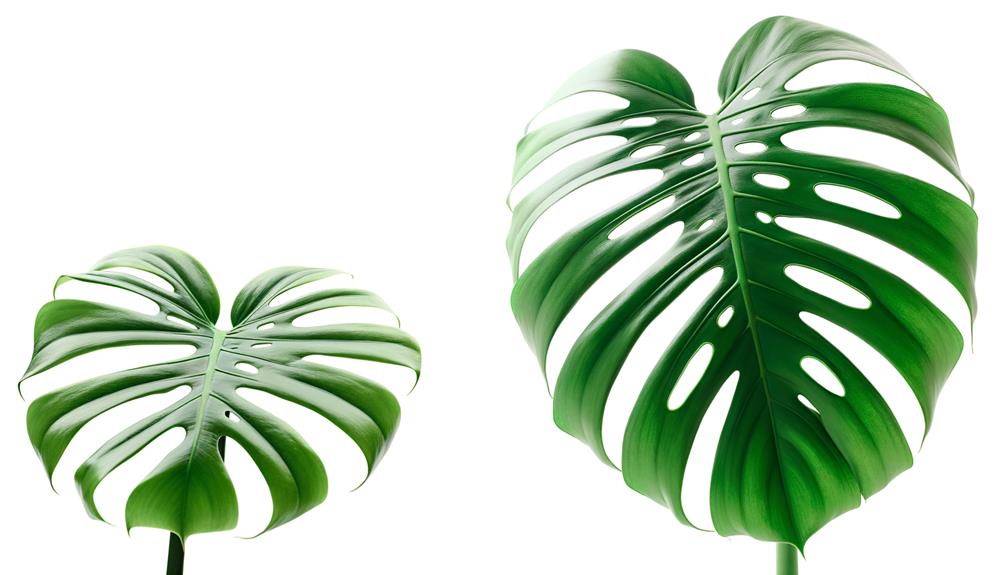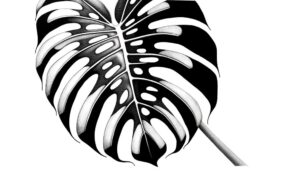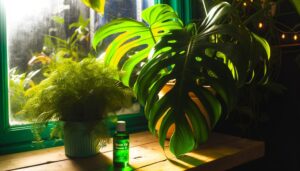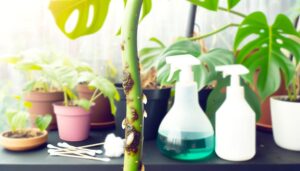What Are the Differences Between Monstera Deliciosa S and M?
Monstera Deliciosa S and M exhibit distinct differences in growth rates and leaf characteristics. Monstera S grows slower, reaching 2-3 feet with heart-shaped, 6-8 inch leaves.
In contrast, Monstera M can grow 10-15 feet annually, featuring 12-inch, fenestrated leaves and a more leathery texture. Monstera M's extensive fenestration patterns and rapid growth make it ideal for spacious settings.
Both plants require bright, indirect light and specific soil mixes, but Monstera S maintains a bushier form. Proper watering and humidity are essential for both.
If you wish to explore more about their care and features, there's plenty to discover.

Key Takeaways
- Monstera Deliciosa S grows to 2-3 feet, while Monstera Deliciosa M can reach 10-15 feet.
- Monstera Deliciosa S has 6-8 inch heart-shaped leaves; Monstera Deliciosa M has 12+ inch fenestrated leaves.
- Monstera Deliciosa M exhibits more elaborate and numerous fenestrations compared to Monstera Deliciosa S.
- Monstera Deliciosa S grows bush-like, whereas Monstera Deliciosa M climbs and spreads.
- Monstera Deliciosa M grows 1-2 feet annually, whereas Monstera Deliciosa S has a slower growth rate.
Size and Growth Rate
When comparing Monstera Deliciosa S and M, you'll notice that Monstera Deliciosa S generally exhibits a slower growth rate and attains a smaller mature size compared to Monstera Deliciosa M.
Monstera Deliciosa S typically reaches a height of 2-3 feet, whereas Monstera Deliciosa M can grow up to 10-15 feet under ideal conditions.
The slower growth rate in Monstera Deliciosa S is attributed to its genetic composition, which limits its vertical and horizontal expansion. Studies have shown that Monstera Deliciosa M can achieve a growth increment of 1-2 feet annually, given sufficient light, humidity, and nutrients.
This makes Monstera Deliciosa M more desirable for those seeking rapid, substantial growth in their indoor or outdoor spaces.
Leaf Shape and Size
Monstera Deliciosa S exhibits smaller, more compact leaves compared to the larger, more fenestrated foliage of Monstera Deliciosa M. You'll notice that Monstera Deliciosa S leaves are generally heart-shaped and maintain a consistent size, making them ideal for limited spaces.
In contrast, Monstera Deliciosa M produces notably larger leaves, which are more expansive and robust.
Consider the following differences:
- Leaf Size: Monstera S leaves average 6-8 inches, while Monstera M leaves can exceed 12 inches.
- Shape Consistency: Monstera S maintains uniform leaf shapes; Monstera M shows more variability.
- Surface Texture: Monstera S has smoother leaf surfaces, whereas Monstera M exhibits a more leathery texture.
- Growth Habit: Monstera S grows more bush-like; Monstera M tends to climb and spread.
Fenestration Patterns
When examining fenestration patterns in Monstera Deliciosa S and M, you'll notice distinct differences in leaf split characteristics.
Monstera Deliciosa M typically exhibits more mature and extensive fenestrations compared to the S variant.
Research indicates that these variations are closely tied to the plant's maturity and environmental conditions.
Leaf Split Characteristics
Fenestration patterns in Monstera deliciosa are a key characteristic that distinguishes different sizes, with larger specimens typically displaying more pronounced and numerous splits in the leaves. You'll observe that the leaf splits, or fenestrations, vary significantly between the smaller and medium sizes.
Here are key points to note:
- Leaf Size: Larger leaves tend to have more extensive fenestration.
- Number of Splits: Medium-sized Monstera leaves often exhibit increased numbers of splits compared to smaller ones.
- Split Depth: The fenestrations in larger specimens usually penetrate more deeply into the leaf blade.
- Pattern Symmetry: Medium-sized leaves display more symmetrical and evenly distributed fenestration patterns.
These leaf characteristics are essential for identifying Monstera deliciosa sizes and understanding their growth patterns.
Maturity and Fenestration
As the plant matures, you'll notice that the fenestration patterns become increasingly intricate and pronounced, reflecting its advanced growth stage.
Monstera deliciosa S usually exhibits smaller, less frequent fenestrations compared to Monstera deliciosa M. In the S variety, fenestrations may appear as simple perforations near the leaf margins.
Conversely, the M variety displays more elaborate and numerous fenestrations, often extending towards the midrib of the leaf. This difference in fenestration density and complexity is attributed to the genetic variation between the two sizes, with M plants having enhanced growth hormones facilitating more extensive leaf development.
Observing these patterns can help you determine the plant's age and overall health, providing insights into its developmental progress.
Light Requirements
Both Monstera Deliciosa S and M thrive under bright, indirect light, although they can tolerate lower light conditions with varying degrees of growth efficiency. Exposure to ideal light levels promotes photosynthesis, which is essential for their lush foliage and fenestration development.
To optimize your Monstera's health, consider the following:
- Bright, Indirect Light: Position near east or north-facing windows.
- Filtered Light: Use sheer curtains to diffuse direct sunlight.
- Artificial Light: Supplement with grow lights during shorter days.
- Low Light Tolerance: Growth slows, and fenestration may be limited.
Scientific evidence indicates that insufficient light can lead to leggy growth and smaller leaves. Conversely, excessive direct sunlight can cause leaf burn, compromising the plant's overall well-being.
Watering Needs
When considering the watering needs of Monstera Deliciosa S and M, you'll need to adjust the frequency based on pot size and plant maturity. Monstera S typically requires more frequent watering due to its smaller root system and faster soil drainage.
Additionally, both varieties exhibit seasonal changes in soil moisture preferences, demanding more water during their active growing periods in the spring and summer.
Frequency of Watering
Monstera Deliciosa S and M have distinct watering needs, with Monstera Deliciosa S generally requiring less frequent watering than its larger counterpart. The smaller plant's reduced leaf surface area results in lower transpiration rates, leading to less water loss.
To optimize hydration, consider the following:
- Monitor Soil Dryness: Before watering, check the top 2-3 inches of soil; it should feel dry to the touch.
- Adjust for Seasonality: Water less frequently during winter dormancy and more in the active growing season.
- Environmental Factors: Take into account humidity and temperature, as higher levels increase water needs.
- Pot Size and Drainage: Ensure adequate drainage to prevent waterlogging, which is detrimental to root health.
Soil Moisture Preference
Understanding the soil moisture preferences of Monstera Deliciosa S and M is important for promoting their peak growth and health. Both varieties thrive in well-draining soil that retains some moisture without becoming waterlogged. You should aim for soil that feels slightly damp to the touch but not soggy.
Monstera Deliciosa S generally prefers a bit drier soil compared to Monstera Deliciosa M, which enjoys consistently moist conditions. To achieve this, use a soil mix rich in organic matter and promote proper drainage. Overwatering can lead to root rot, while underwatering can stress the plant.
Employ a soil moisture meter to accurately gauge moisture levels and adjust your watering practices accordingly. This promotes ideal hydration and prevents common issues.
Seasonal Watering Changes
Adjusting your watering schedule according to the changing seasons is essential for maintaining the health of Monstera Deliciosa S and M. Their water needs fluctuate with temperature and light variations. During the growing season (spring and summer), these plants require more frequent watering due to increased transpiration and higher metabolic activity.
Conversely, in the dormant period (fall and winter), their water needs diminish. To optimize watering:
- Spring/Summer: Water thoroughly when the top 2 inches of soil are dry.
- Fall/Winter: Reduce watering frequency, allowing the top 3-4 inches to dry.
- Humidity: Maintain consistent humidity levels around 60-70%.
- Light: Make sure they receive indirect, bright light to avoid stress.
Adapting to these seasonal changes helps prevent root rot and other water-related issues.
Soil Preferences
Both Monstera Deliciosa S and M flourish best in well-draining, aerated soil rich in organic matter. You should use a mix that includes peat moss, perlite, and pine bark to optimize conditions. This combination allows for excellent drainage while retaining necessary moisture and nutrients.
| Soil Component | Function |
|---|---|
| Peat Moss | Retains moisture and nutrients |
| Perlite | Increases aeration and drainage |
| Pine Bark | Provides structure and organic matter |
Using a soil mix tailored to these needs prevents root rot and promotes healthy growth. Regularly check the soil's pH; it should remain slightly acidic, around 5.5 to 7.0. Adjusting your soil composition ensures your Monstera Deliciosa S and M receive the ideal environment for thriving.
Ideal Humidity Levels
Monstera Deliciosa S and M thrive in environments with humidity levels between 60% and 80%, as this range closely mimics their natural tropical habitat. Maintaining these humidity levels is essential for best growth and health.
To achieve this, you can:
- Use a humidifier: This device can help maintain consistent humidity.
- Group plants together: Plants naturally release moisture, increasing local humidity.
- Mist regularly: Spraying water on the leaves can temporarily boost humidity.
- Place near water sources: Positioning plants near aquariums or water bowls can also elevate humidity levels.
Adhering to these practices guarantees that your Monstera Deliciosa S and M receive the moisture they need, fostering robust growth and vibrant foliage.
Regular monitoring with a hygrometer is recommended to maintain appropriate conditions.
Common Pests and Diseases
While ideal humidity levels support healthy growth, keeping an eye out for common pests and diseases like spider mites, scale insects, and root rot is equally important for maintaining the well-being of your Monstera Deliciosa S and M. Spider mites often appear as tiny, web-spinning pests that induce leaf discoloration. Scale insects latch onto stems and leaves, extracting vital sap, leading to yellowing foliage. Root rot, generally caused by overwatering, results in blackened, mushy roots and stunted growth. Regularly inspect your plants and utilize appropriate treatments like neem oil for pests and well-draining soil to prevent root rot.
| Pest/Disease | Symptoms | Treatment |
|---|---|---|
| Spider Mites | Leaf discoloration, fine webs | Neem oil, miticides |
| Scale Insects | Yellowing foliage, sap extraction | Horticultural oil |
| Root Rot | Blackened roots, stunted growth | Well-draining soil |
Conclusion
To sum up, understanding the differences between Monstera deliciosa S and M is essential for the best care. Think of it like tuning a musical instrument; each variation requires precise adjustments.
Both benefit from bright, indirect light and well-draining soil, but their growth rates, leaf shapes, and fenestration patterns differ.
Regularly monitor humidity and watch for pests like spider mites. By tailoring your care to these specific needs, you'll cultivate a flourishing, lively Monstera collection.






